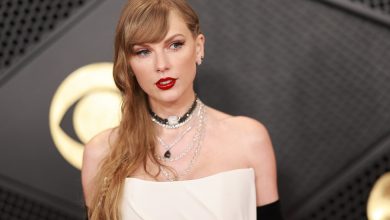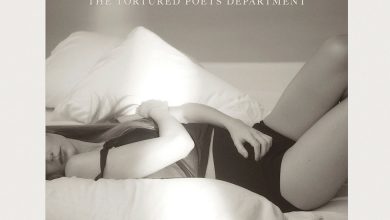Review: What Does Ballet Need Now? Not Retro Fantasy.

Tony Bennett has long lived by a basic tenet: When everybody zigs, he zags. For him, it’s a mantra — he prefers to go his own way — but as language, it’s also full of motion, like a dance phrase about to be born. For the past couple of years, the choreographer Jessica Lang has found inspiration in pairing his smooth, versatile voice with moving bodies that have been known to zig. And zag.
As part of American Ballet Theater’s fall gala presented Tuesday, Lang unveiled the premiere of “ZigZag,” her latest, to 10 songs recorded by Bennett. In “It’s De-Lovely,” he’s joined by Lady Gaga; theirs is a musical partnership that has been as fortifying as it is sweet. But the same can’t be said of “ZigZag,” which is like one of those gleaming, architectural desserts held together by a web of spun sugar — you take a bite and realize it’s made of air.
Is another ballet set to songs sung by Bennett — “Let Me Sing Forevermore,” Lang’s 2019 pas de deux, has been a feature of the company’s repertory during the pandemic — what the world needs now? “ZigZag,” a tribute to Bennett and to American popular song, does lead off with “What the World Needs Now.” And clearly, the world could use some love, the only thing, Bennett sings, that there’s just too little of. But this 30-minute ballet feels stuck in a fantasy past, and that isn’t helped by the nearly period costumes, by Wes Gordon for Carolina Herrera.
The male leads wear white, and even though they aren’t sailors, it’s hard not to think about “On the Town.” The three female leads are in bright dresses — fuchsia, royal blue, canary yellow — cut in a 1950s silhouette with the eau of ladies who lunch. The dancers, including the ensemble, in either black or polka dots, fully embrace over-the-top abandon and emotion, prodded on by the music. But “ZigZag” — formulaic at best and clueless at worst — feels hopelessly regressive.
With scenery by Derek McLane, who incorporates a zigzag design (it’s like the ghost of Charlie Brown haunting the stage), images of the New York skyline and artwork by Bennett, the production features 14 dancers in total. While Lang does a good job showing her skill at moving dancers in and out of her choreographic structures — they breeze by in sleek jumps and dash along with purpose — her way of tying gestures to the lyrics lives on the surface, just as the song selection feels like a K-tel compilation of greatest hits.
Cory Stearns sweeps through “I Left My Heart in San Francisco” with silky turns and a fluent eloquence; two numbers later, we’re back in New York with Devon Teuscher in “Spring in Manhattan” with a jaunty — forgive me — spring in her step. Cassandra Trenary, with Joo Won Ahn, tears up the stage in “De’Lovely” with frantic lifts and some powerful skirt swishing. Then, in “Smile,” the focus in on the troubled, intertwined relationships of Teuscher, Luciana Paris, Stearns and Blaine Hoven. It has all the yearning arms and lingering glances you would expect, and then more, in a dance set to a song that tells you to “smile though your heart is aching.”
As the curtain fell on “How Do You Keep the Music Playing,” the dancers were still in motion, still traversing the stage like a flock of birds as if they could have kept going forever. And the dance very well could have; “ZigZag” held its shape only within each song. There was no greater whole.
That ballet was the closer of a meandering evening that started with speeches by Misty Copeland and others, as well a film highlighting the A.B.T. Women’s Movement, an initiative to increase the number of female choreographers. The dancing portion of the program included works by Lauren Lovette, Darrell Grand Moultrie and Christopher Rudd. In the stage premiere of “Touché,” Rudd left little to the imagination in his depiction of a gay relationship featuring Calvin Royal III (Adam) and João Menegussi (Steve).
Originally a digital work, it touched on themes of trauma, bullying and self-acceptance and ended with a steamy kiss as the dancers rolled across the floor. The audience went nuts. But as a psychological dance drama, “Touché” was overly literal; that stunted its power.
Along with a short excerpt from Moultrie’s “Indestructible Light” — set to jazz recordings, the piece will be performed in its entirety during the rest of Ballet Theater’s season — the company presented Lovette’s charming “La Follia Variations.” Set to music composed by Francesco Geminiani as arranged and reimagined by Michi Wiancko, the ballet is a joyful expression of taking movement to its limits.
Lovette, who recently retired from City Ballet to focus more time on choreography, created “La Follia” in 2020 for Ballet Theater’s Studio Company when New York City was about to enter lockdown. She has remounted it for the main company — reworking parts of it — but it retains a youthful spark and the notion of time slipping away: dancing in the last crack of light before the curtain falls.
It starts with a line of dancers stretching from the front of the stage to the back. In an instant, they are in motion as the men spin in place and the women splinter off to the sides. Soloists peel out of ensemble numbers and fold back into the group, wearing Victor Glemaud’s jewel-colored, off-one-shoulder designs. Tutus bounced adorably.
Certain hand and arm movements feel tacked on — Lovette’s work, detailed enough, doesn’t need the excess so common in contemporary ballet — while the lighting, by Brad Field, could overly mimic the shifts of the music from exuberance to something more understated. Sometimes, you had to look closely to see the most striking details. In an intimate duet, Chloe Misseldine stretched into a regal arabesque on pointe as Jose Sebastian, with one hand placed gently at her waist, rotated her in the smoothest of promenade turns.
There could have been more consistency, but the dancers didn’t play it safe. “La Follia” epitomizes a way of moving that echoes Lovette herself. Her retirement has been a hard one to wrap the mind around, but it’s still possible to experience something of her luscious dancing in her choreography: anxious and heartfelt, spellbinding in its quieter moments but always, gloriously, alive.
American Ballet Theater
Through Sunday at the David H. Koch Theater, Lincoln Center; abt.org.




